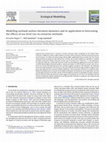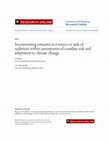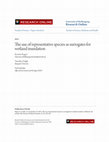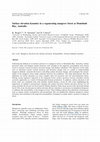Papers by Kerrylee Rogers
Australian Journal of Water Resources, 2014
In 2011, the Australian government proposed the Murray-Darling Basin Plan to promote a healthy wo... more In 2011, the Australian government proposed the Murray-Darling Basin Plan to promote a healthy working river system. The proposed Plan seeks to limit surface water (consumptive) use to 10873 GL/year on a long-term average. The controversy prompted by this proposed reduction in extractive allocations has underscored the need for transparent and objective modelling of ecological benefi ts. In this paper, we investigate the likely ecological outcomes of the proposed plan for the Macquarie Marshes, a Ramsar-listed wetland in the Murray-Darling Basin, using a decision support system (DSS)

Estuarine, Coastal and Shelf Science, 2014
ABSTRACT The response of coastal wetlands to sea-level rise is receiving global attention and obs... more ABSTRACT The response of coastal wetlands to sea-level rise is receiving global attention and observed changes in the distribution of mangrove and salt marsh are increasingly associated with global climate change, particularly sea-level and temperature rise, and potentially elevated carbon dioxide. Processes operating over smaller-spatial scales, such as rainfall variability and nutrient enrichment are also proposed as possible short-term drivers of changes in the distribution of mangrove and salt marsh. We consider the response of mangrove and salt marsh in a subtropical estuary to changes in environmental variables over a 12 year period by comparing rates of surface elevation change and vegetation distribution dynamics to hydrological and climatic variables, specifically water level and rainfall. This period of analysis captured inter-annual variability in sea level and rainfall associated with different phases of the El Nino Southern Oscillation (ENSO). We found that the mangrove and salt marsh trend of increasing elevation was primarily controlled by position within the tidal prism, in this case defined by inundation depth and distance to the tidal channel. Rainfall was not a primary driver of elevation trends in mangrove and saltmarsh, but rainfall and water level variability did influence variability in elevation over the study period, though cross-correlation of these factors confounds identification of a single process driving this variability. These results highlight the scale-dependence of coastal wetland vegetation distribution dynamics; the longer-term trend of surface elevation increase and mangrove encroachment of salt marsh correlated with global sea-level trends, while short-term variability in surface elevation was related to local variability in water level and rainfall. Rates of surface elevation increase were found to lag behind rates of water level change within the Tweed River, which may facilitate further expansion of mangrove into salt marsh. This study advocates integration of ecological and geomorphic techniques to understand the response of coastal wetlands to sea-level rise and climatic perturbations.

New Phytologist, 2014
A global trend of woody plant encroachment of terrestrial grasslands is co-incident with woody pl... more A global trend of woody plant encroachment of terrestrial grasslands is co-incident with woody plant encroachment of wetland in freshwater and saline intertidal settings. There are several arguments for considering tree encroachment of wetlands in the context of woody shrub encroachment of grassland biomes. In both cases, delimitation of woody shrubs at regional scales is set by temperature thresholds for poleward extent, and by aridity within temperature limits. Latitudinal expansion has been observed for terrestrial woody shrubs and mangroves, following recent warming, but most expansion and thickening has been due to the occupation of previously water-limited grassland/saltmarsh environments. Increases in atmospheric CO₂, may facilitate the recruitment of trees in terrestrial and wetland settings. Improved water relations, a mechanism that would predict higher soil moisture in grasslands and saltmarshes, and also an enhanced capacity to survive arid conditions, reinforces local mechanisms of change. The expansion of woody shrubs and mangroves provides a negative feedback on elevated atmospheric CO₂ by increasing carbon sequestration in grassland and saltmarsh, and is a significant carbon sink globally. These broad-scale vegetation shifts may represent a new stable state, reinforced by positive feedbacks between global change drivers and endogenic mechanisms of persistence in the landscape.
Masselink/Coastal Environments and Global Change, 2015

Empirical data derived from a network of surface elevation tables established on the Hunter River... more Empirical data derived from a network of surface elevation tables established on the Hunter River, Australia, in 2000 was used to model sediment accretion within estuarine wetlands using factorial analysis of variance. As surface elevation change did not differ significantly from accretion over the 10 year study period in the mangrove and saltmarsh (p = 0.4104), the accretion model was regarded as a reliable estimate of elevation change. Using the current rate of sea-level rise (3.65 mm y −1 ), a rate deemed to be relatively moderate, a landscape elevation model was developed by applying the accretion model to a LiDAR-derived digital elevation model at annual increments to 2050. Based on current rates of sealevel rise and the intertidal elevation that currently supports mangrove and saltmarsh, the landscape elevation model projected a 16% increase in the area within the elevation range suitable to support mangrove and saltmarsh. This contrasts 'bathtub modelling', which projected a 6% decline in wetland extent. Bathtub modelling fails to account for the ability of mangrove and saltmarsh to accommodate sea-level rise through processes of accretion, shrink-swell of sediments and the accumulation of organic material. Results from the landscape elevation model suggest that planning for sea-level rise should be directed towards facilitating wetland adaptation by promoting tidal exchange to mangrove and saltmarsh and providing land for wetland migration.

Complex coastal landforms exhibit variable behaviour in response to sea-level rise. A proposed mo... more Complex coastal landforms exhibit variable behaviour in response to sea-level rise. A proposed modelling framework that integrates shoreline changes associated with longterm recession, short-term variability and sea-level rise advocates that coastal risk assessment be undertaken within the context of a geomorphologically-based modelling framework whereby a coastline is subdivided into coastal compartments or cells, thereby recognising the sedimentary links between compartments. For example, the Narrabeen coastline includes bounding headland compartments, a bay compartment and an estuary compartment; and the behaviour of the coastline varies according to the response of each of these compartments to variable climatic and oceanic conditions. This approach is extended to other estuarine systems in southern NSW. Estuaries play an important role as a source or sink of sediment that varies widely in accordance with climatic and oceanic conditions. Accounting for the role of estuaries in coastline behaviour involves identifying the variable shorelines within estuaries; establishing the long-term estuarine shoreline behaviour and the response of shorelines to sea-level change; and integrating models that best represent the response of estuarine shorelines to climate change within the proposed integrated modelling framework for coastal risk assessment. Recognising the links between sedimentary sources and sinks and integrating models of estuarine behaviour with models of open coast behaviour will improve coastal risk assessment and provide greater confidence in adaptation options.
Coastal saltmarsh has been listed as an Endangered Ecological Community in New South Wales. Recen... more Coastal saltmarsh has been listed as an Endangered Ecological Community in New South Wales. Recent research has highlighted the importance of coastal saltmarsh as a source of nutrition for fish, a nocturnal feeding habitat for microbats, and a roosting habitat for several species of migratory shorebirds. Since European colonisation, coastal saltmarsh has been reclaimed for agricultural, residential and industrial use,

Wetlands, 2012
The complex task of determining the inundation requirements of large floodplain wetlands is often... more The complex task of determining the inundation requirements of large floodplain wetlands is often simplified through the use of representative, umbrella or flagship species. This subset of species is targeted based on the assumption that their collective inundation requirements serve as a surrogate for the broader suite of species found within the wetland. We tested the application of representative species commonly used in wetland and water management planning in the Murray-Darling Basin. In a review of the water requirements of 155 plants and animals, we collated information on preferred inundation timing, duration, depth, rate of rise and fall, and inter-flood period for 115 species. We then used cluster analysis to determine the extent to which ten commonly used representative species corresponded in inundation requirements to the broader suite of species. We found that the habitat surrogates of river red gum, black box, spike rush, coolibah, water couch, lignum and marsh club-rush represented only one third of species at a 60% level of similarity in inundation requirements, due mainly to the lower inundation return period and duration required by the habitat surrogates. The addition of faunal representative species facilitated the inclusion of a broader range of requirements, though primarily amongst related taxa. We recommend the inclusion of several additional indicator species to more adequately cover the inundation requirements of large wetland ecosystems.
Wetlands Ecology and Management, 2012

Wetlands Ecology and Management, 2005
Following the dieback of an interior portion of a mangrove forest at Homebush Bay, Australia, sur... more Following the dieback of an interior portion of a mangrove forest at Homebush Bay, Australia, surface elevation tables and feldspar marker horizons were installed in the impacted, intermediate and control forest to measure vertical accretion, elevation change, and shallow subsidence. The objectives of the study were to determine current vertical accretion and elevation change rates as a guide to understanding mangrove dieback, ascertain the factors controlling surface elevation change, and investigate the sustainability of the mangrove forest under estimated sea-level rise conditions. The study demonstrates that the influences on surface dynamics are more complex than soil accretion and soil autocompaction alone. During strong vegetative regrowth in the impacted forest, surface elevation increase exceeded vertical accretion apparently as a result of belowground biomass production. In addition, surface elevation in all forest zones was correlated with total monthly rainfall during a severe El Nin˜o event, highlighting the importance of rainfall to groundwater recharge and surface elevation. Surface elevation increase for all zones exceeded the 85-year sea level trend for Sydney Harbour. Since mean sea-level also decreased during the El Nin˜o event, the decrease in surface elevation did not translate to an increase in inundation frequency or influence the sustainability of the mangrove forest. These findings indicate that subsurface soil processes such as organic matter accumulation and groundwater flux can significantly influence mangrove surface elevation, and contribute to the long-term sustainability of mangrove systems under a scenario of rising sea levels.

Marine and Freshwater Research, 2013
We review the distribution, status and ecology of Australian saltmarshes and the mechanisms where... more We review the distribution, status and ecology of Australian saltmarshes and the mechanisms whereby enhanced atmospheric carbon dioxide and associated climate change have influenced and will influence the provision of ecosystem goods and services. Research in temperate and subtropical saltmarsh has demonstrated important trophic contributions to estuarine fisheries, mediated by the synchronised massspawning of crabs, which feed predominantly on the C-4 saltmarsh grass Sporobolus virginicus and microphytobenthos. Saltmarshes also provide unique feeding and habitat opportunities for several species of threatened microbats and birds, including migratory shorebirds. Saltmarshes increased in extent relative to mangrove in Australia in both tide-and wave-dominated geomorphic settings through the latter Holocene, although historic trends have seen a reversal of this trend. Australian saltmarshes have some capacity to maintain elevation with respect to rising sea level, although in south-eastern Australia, the encroachment of mangrove and, in Tasmania, conversion of shrubland to herbfield in the past half-century are consistent with changes in relative sea level. Modelling of the impacts of projected sea-level rise, incorporating sedimentation and other surface-elevation drivers, suggests that the survival of saltmarsh in developed estuaries will depend on the flexible management of hard structures and other impediments to wetland retreat.
Uploads
Papers by Kerrylee Rogers